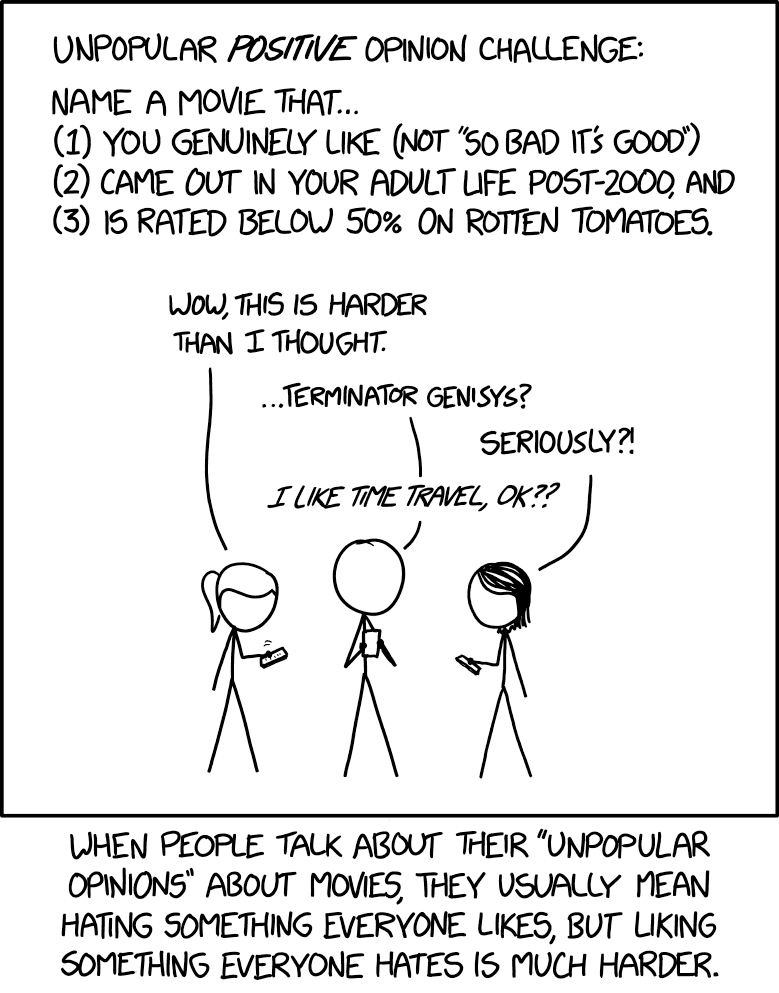Yeah, I guess I’ve got to leave it like that now…
- 23 Posts
- 367 Comments
Got will not delete untracked files though, which is what happened here. If you want to discard changes to a file with git, you first have to commit the file to the index at some point, which means there’s only ever so much damage an erroneous “git restore” or “git reset” can do. Specifically, neither of them will delete all the files in an existing project where VC has just been added.
If you have set up your staging area for a commit you may want to discard (unstage) changes from the staging area, as opposed to discarding changes in the working directory.
Of course, the difference between the two is obvious if you’re using git CLI, but I can easily see someone using a GUI (and that maybe isn’t too familiar with git) misunderstanding “discard” as “unstage”.
Either way, what happened here indicates that all the files were somehow added to the VC, without having been committed first, or something like that, because git will not let you discard a file that is untracked, because that wouldn’t make any sense. The fact that the GUI let this person delete a bunch of files without first committing them to the index is what makes this a terrible design choice, and also what makes the use of the word “discard” misleading.
I use gitkraken for two primary purposes:
-
Having a visual representation of my project history.
-
resolving merge conflicts
Of these, the first is really the only thing I really want a GUI for. I’ll just have it open on my side-screen if I’m managing some more or less messy branch structure or quickly want an overview of what has been done on which branches, where common ancestors are, etc. All the actual doing of things is done from the CLI, because it’s just better for that.
-

 4·5 days ago
4·5 days agoKeeping the kids safe!
Absolutely! I remember going from “holy shit this guy is terrifying and we have video evidence of him being able to kick ass” to “what the fuck? These not-as-terrifying looking people are messing him up bad!”

 4·8 days ago
4·8 days agoThere’s a lot of good advice here already, especially that wool is the gold standard - nothing synthetic cuts it. I want to add that the absolute key is about layering, and not over-stuffing.
What keeps you warm is primarily the air trapped between your layers, which means that three thin layers can be a lot better than one thick layer. This also means that you will be freezing if your layers are too tight. If you have two thin layers, and put on a sweater, and that sweater feels tight, that likely means you’re pushing out the air trapped in your inner layers, and they won’t be as effective. The same applies when putting on a jacket.
So: You want a thin base layer (think light, thin wool shirt + long johns), then an optional medium layer or two (slightly thicker wool shirt, I have some in the range of 200 grams), and finally a thicker sweater for when you’re not moving. These should increase in size so that they can fit the thinner layers underneath, and you want your jacket big enough to fit all the underlying layers.
Finally: When you’re moving around, you will get stupidly warm and sweaty unless you take off clothes. It’s better to take off some stuff and be a bit cold for the first 10 minutes of moving than to get sweaty and be cold for the rest of the day. If (when) you do get cold, running in a circle for 10 min will fix it (run at a calm, steady pace, if you’re really cold it might take longer to get warm than you think, but you will get warm if you move).
In short: Being in a cold climate is just as much about how you use your equipment, and how you activate yourself to stay warm, as it is about what equipment you have.
Watch me: My
void*doesn’t give a shit about yourconst!
I have to be honest in that, while I think duck typing should be embraced, I have a hard time seeing how people are actually able to deal with large-scale pure Python projects, just because of the dynamic typing. To me, it makes reading code so much more difficult when I can’t just look at a function and immediately see the types involved.
Because of this, I also have a small hangup with examples in some C++ libraries that use
auto. Like sure, I’m happy to useautowhen writing code, but when reading an example I would very much like to immediately be able to know what the return type of a function is. In general, I think the use ofautoshould be restricted to cases where it increases readability, and not used as a lazy way out of writing out the types, which I think is one of the benefits of C++ vs. Python in large projects.

 5·11 days ago
5·11 days agoNah, but the Russians took massive losses at some point last year (I seem to remember) because the Ukrainians launched a bunch of mines behind an attacking column, so that when the column was beaten back, they ran straight into a newly placed mine field.
My impression is that remote mining is used for two purposes: Defensively, you can break up or slow down an advance by suddenly laying mines either in front of, in the middle of, or behind, an advancing column (the latter preventing reinforcements from arriving, or the attacking force from an orderly retreat). Offensively, you can use remote mine laying to cover the flanks of an advancing force, or prevent reinforcements from reaching a position you’re attacking.

 11·11 days ago
11·11 days agoRemoved by mod

 4·11 days ago
4·11 days ago(…) what you said can be construed as offensive.
So what? You have a personal responsibility for being offended. It’s not everybody else’s job to walk on eggshells to avoid offending you. If you go looking for things people have said that can offend you, you’re gonna have a shitty time.
Try making an effort to interpret people in the best possible way, and you’ll have a much better time, with much fewer people being perceived as “going after you”.

 33·12 days ago
33·12 days agoUsing the wrong filament isn’t Darwin Award worthy. Test firing a newly manufactured weapon with your hand is. And that would be true even if this wasn’t an experimental home-made design…

 41·13 days ago
41·13 days agoI definitely think the ramping up is going far too slowly, and as such it isn’t strange that there are shortages.
This is a huge war- the largest land war since WWII. All of NATO is still operating on a peace-time economy, so ramping up production to the levels required to support a 500 k - 1 mill. strong army like the Ukrainians is taking far too long.
However, as far as I can tell, production in Europe is only heading one way: Up. Not only that, Russia is operating in a war economy, which is, more or less by definition, unsustainable in the long run. Europe has the economic capacity to double its production, and maintain it indefinitely. I just think we should prioritise more heavily, and scale up more quickly.

 51·13 days ago
51·13 days agoThe amount of people I’ve been helping out that have copied some code from somewhere and say “it doesn’t work”, and who are dumbfounded when I ask them to read the surrounding text aloud for me…
Along the same line: When something crashes, and all I have to do is tell people to read the error message aloud, and ask them what that means. It’s like so many people expect to be spoon-fed solutions, to the point where they don’t even stop to think about the problem if something doesn’t immediately work.

 9·13 days ago
9·13 days agoOnce again proving that mobile armour most definitely has a place on the modern battlefield, and the importance of good armour!
Here’s to hoping these guys are still in shape to keep it up and train others. And let’s get moving on sending more of these and everything else that can protect them while they throw out the Russians!

 61·13 days ago
61·13 days agoIt seems to me like most European countries see supplying equipment to destroy the Russian army in Ukraine as preferable to destroying the Russian army on their own soil. Although I do hope Germany picks up the pace rather than reduces it.
However, even without Germany, there are plenty of other European countries that will be capable of buying truckloads of equipment from German manufacturers.

 5·13 days ago
5·13 days agoI can’t even begin to imagine what this must have been like… I’m wondering about several things:
-
What kind of reaction was there to your dissapearance? Have you ever looked up any archives to find out what happened in the days after you dissapeared?
-
What is your life like now?
-
While I do agree with most of what is said here, I have a hangup on one of the points: Thinking that “docstrings and variable names” are a trustworthy way to indicate types. Python is not a statically typed language - never will be. You can have as much type hinting as you want, but you will never have a guarantee that some variable holds the type you think it does, short of checking the type at runtime. Also, code logic can change over time, and there is no guarantee that comments, docstrings and variable names will always be up to date.
By all means, having good docstrings, variable names, and type hinting is important, but none of them should be treated as some kind of silver bullet that gets you around the fact that I can access
__globals__at any time and change any variable to whatever I want if I’m so inclined.This doesn’t have to be a bad thing though. I use both Python and C++ daily, and think that the proper way to use Python is to fully embrace duck typing. However that also means my code should be written in such a way that it will work as long as whatever input to it conforms loosely to whatever type I’m expecting to receive.












Fair enough, git clean does exist. However, if the button saying “discard all changes” is really a button that runs
git clean, that’s just a plain terrible design choice.git cleanis “delete all untracked files”, which is specifically not discarding changes, because there can be no changes to discard on an untracked file. Even talking about “changes” to an untracked file in VC context makes little sense, because the VC system doesn’t know anything about any changes to the file, only whether it exists or not.That’s not even mentioning the fact that the option to “git clean” shows up as one of the easily accessible options in relation to a staging process. Especially if you’re coming from the git CLI, you’re likely to associate “discard changes” with “git restore”.